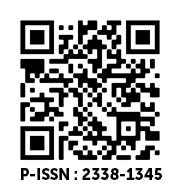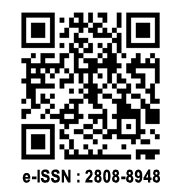The integrated disease management of early blight in organically grown tomato under hill condition of Sikkim, India
DOI:
https://doi.org/10.36782/apjsafe.v11i2.231Keywords:
Organic Agriculture, Tomato, Bio agent, Integrated disease managementAbstract
Tomato (Lycopersicon esculentum Mill.) is the most widely cultivated vegetable crop in the world and early blight caused by Alternaria spp. is one of the major production constraints. Survey was conducted during kharif seasons of 2018-19 &2019-20 in four districts of Sikkim. Maximum early blight disease severity was recorded in south district of Sikkim. Pathogenicity test of isolates collected from different location were established. Morphological, cultural, and molecular identification of the pathogen reveal pathogen as Alternaria spp. Five different bio-control agents i.e., Trichoderma harzianum, T. Viride, Pseudomonas fluorescens, Bacillus subtilis and Bacillus cereus were evaluated against the test pathogens. Among the bio-control agents tested, Trichoderma harzianum (74.89%) and Trichoderma viride (69.41%) showed maximum percent growth inhibition. Open field experiment was conducted with eleven treatments formulated by integrating the different organic inputs, biocontrol agents and copper-based fungicide as chemical check. Organic treatment T9 {Susceptible Variety + Soil treatment with Trichoderma harzianum @1:25(1kg Trichoderma + 25 Kg of FYM) + cow dung slurry 10% + Nimbicidine 0.3% + Panchagavya 10% + Cow Urine 10%} consistently showed the best result among the bioresources tested.
Keywords: Tomato, Organic, Bio agent and Integrated disease management
Downloads
References
Agrios, G.N., 2005. Plant pathology. 5th Edition, Academic Press, New York, USA, 2005, 1−922.
Attri, K., Gupta, P., Kansal, S., Gupta, M. & Goswami, M. (2020). Early blight disease management of tomato through use of native bioresources in mid hills of Himachal Pradesh. International Journal of Bio-resource and Stress Management., 11(2): 153-158.
Chanthini, K., Kumar, C.S. and Kingsley, S.J. (2012).Antifungal activity of seaweed extracts against phytopathogen Alternaria solani.Journal of Academia and Industrial Research.,1(2):86-90
Dalpati, N. N. S., Parate, R. L. and Ingle, S. T. (2010). Efficacy of some bioagents and botanicals against Alternaria macrospora causing leaf spot of cotton. Journal of Plant Disease Sciences., 5 (1): 95-97
Debbarma, S., Zacharia, S., Simon, S. (2017). Effect of plant extracts on early blight of potato (Solanum tuberosum L.). Journal of Pharmacognosy and Phytochemistry. 6(4): 1415−1417.
Deshmukh, P. P. and Raut, G. J. (1992). Antagonism by Trichoderma spp. on five plant pathogenic fungi. New Agriculture., 3: 127-130
Devi, P.R. (2013). Biology, Epidemiology and Management of Alternaria spp. causing early blight of tomato (Lycopersicon esculentum Mill.). Ph.D. Thesis. Dr. YSR Horticultural University, Andhra Pradesh.
Elad, Y., Chet, I. and Katan, J. (1980). Trichoderma harzianum: A biological agent effective against Sclerotium rolfsii and Rhizoctonia solani. Phytopathology., 70: 119-121.
Ghosh, T and Biswas, M.K. (2018). Evaluation of antibacterial and antifungal activity of cow urine against some seed borne microflora.International Journal of Current Microbiology and Applied Science., 7(5):1714-1727.
Gondal, A.S., Ijaz, M., Riaz, K and Khan, A.R. (2012). Effect of different doses of fungicide (Mancozeb) against Alternaria leaf blight of tomato in Tunnel. Plant Pathology and Microbiology. 3(3): 1-3.
Hadar, Y., Harman, G. E. and Taylor, A. G. (1984). Evaluation of Trichoderma koningii and T. harzianum from New York soils for biological control of seed rot caused by Pythium spp. Phytopathology., 74: 106-110.
Harman, G. E., Chet, I. and Baker, R. (1980). Trichoderma hamatum effects on seed and seedling diseases induced in radish and pea by Pythium spp. or Rhizoctonia solani. Phytopathology., 71: 1167-1172.
Harman, G. E., Chet, I. and Baker, R. (1981). Factors affecting Trichoderma hamatum applied to seeds as a biocontrol agent. Phytopathology., 71: 569-572.
Hassanein, N. M., AbouZeid, M.A., Youssef, K.A. and Mahmoud, D.A. (2010). Control of tomato early blight and wilt using aqueous extract of neem leaves. PhytopathologiaMediterranea., 49: 143–150.
Hosagoudar, G. N., and Chattannavar, S. N. (2013). Management of Alternaria leaf spot disease on Bt cotton through bio agents and botanicals. Bioinfolet.10(3a) :774-778.
Jagadeesh, K.S. and Jagadeesh, D.R. (2009). Biological control of early blight of tomato caused by Alternaria solani as influenced by delivery methods of Pseudomonas gladioli B 25. Acta Horticulture., 808: 327-332.
Knudsen, G. R. and Bin, L. (1990). Effects of temperature, soil moisture and wheat bran on growth of Trichoderma harzianum form alginate pellets. Phytopathology., 80: 724-727.
Kommedahl, T., Windles, C. E., Sarbini, A. and Wiley, H. B. (1981). Variability in performance of biological and fungicidal seed treatment in Corn, Peas and Soybean. Protection Ecology., 3: 55- 61.
Latha, R.D. and Zacharia, S. (2021). Eco-friendly management of early blight of tomato (Lycopersicon esculentum Mill.). Pharma Innovation., 10(10):819-822.
Martinez, B. and Solano, T. (1995). Antagonism of Trichoderma spp. to Alternaria solani (Ellis and Martin) Jones Grout. Revista de proteccion Vegetal., 3: 221-225
Nashwa, S.M.A., Abo-Elyousr, K.A.M. (2012). Evaluation of various plant extracts against the early blight disease of tomato plants under greenhouse and field conditions. Plant Protection Science., 48(2): 74−79.
Papavizas, G. C., Lewis, J. A. and Abd-El-Moity, T. H. (1982). Evaluation of new biotypes of Trichoderma harzianum for tolerance to Benomyl and enhanced biocontrol capabilities. Phytopathology., 72: 126-130.
Patil, M.J., Ukeyand, S.P., Raut, B.T., 2002. Evaluation of fungicides and botanicals for the management of early blight (Alternaria solani) of tomato. PKV Research Journal 25(1), 49−51.
Patilkulkarni, V.G. (2013). Organic management of purple blotch of onion caused by Alternaria porri. M.Sc. Thesis. University of Agricultural Science, Dharwad, Bangalore.
Rao, M. S. L. (2006). Management of Alternaria leaf spot in sunflower. Annual Report 2005- 2006. Direc. Oilseeds Res. 54p.
Shekhawat, P.S. and Prasad, R. (1971). Antifungal properties of plant extracts in inhibition of spore germination. Indian Phytopathology., 24(4): 801−802.
Simmons, E.G. 2007. Alternaria: an identical manual.CBS Biodiversity Series 6: 1−775
Singh, U.P., Pandey, N., Wagner, K.G. and Singh, K.P. (1990). Antifungal activity of agoene. A constituent of garlic (Allium sativum). Canadian Journal of Botany.,68(6): 1354−1356.
Sireesha, O. 2013. Effect of plant products, Panchagavya and bio-control agents on rice blast disease of paddy and yield parameters. International Journal of Research in Biological Sciences, 3(1): 48-50.
Wu, W. S. (1982). Seed treatment by applying Trichoderma spp. to increase the emergence of soybean. Seed Science and Technology., 10: 557-563








